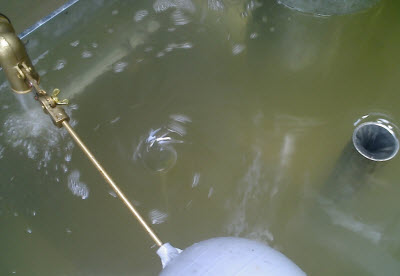The problem of water in the cooling system
Cooling system is the indispensable part of day chuyen da vien.
The water used in the cooling tower which acts as thermal media, we get heat and waste heat out of the air by evaporation. Depending on quality of initial water the resource level in the water in the system will gradually appear the following issues:
1. The problem caused from water with cooling tower
+ Uniform residue
+ Corrosion
+ Micro-organisms development
+ Accumulation of dirt
2. The damage caused
+ Stopped unexpectedly due to machine failure
+ Reduced heat transfer efficiency
+ Increase the amount of water used
+ Increase operating costs and maintenance, costly replacement parts
+ Reduce the lifespan of your system by using the acid sanitary pipe.
3. There is not a single method to handle water in the cooling system that must coordinate the methods together.
Selecting a water treatment program for a particular system depends on factors such as:
+ Design of the system. Including capacity, style, depth, water tank Tower, building materials, heat transfer rate, flow, between the temperature and the related accessories.
+ Water, including water quality, the ingredients in the water, the water treatment system.
+ The restrictions on discharge of waste water.
+ Environment and air quality.

The water in the cooling system
THE IMPORTANT PARAMETERS OF COOLING WATER:
In addition to the parameters related to the design of systems, the water quality is the most important factor to decide to water methods.
The important parameters of cooling water are: conductivity, total dissolved solids (TDS), pH, hardness, alkalinity and the saturation index.
The conductivity and total dissolved solids (TDS):
The conductivity is a measure of electrical conductivity of water and it correlates with the amount of dissolved solids (TDS) in water. Pure distilled water has a very low conductivity (low mineral) and will have a high conductivity water (high-mineral).
The presence of dissolved solids do not have problems related to the cooling capacity of water. However the problem with dissolved solids in that is a lot of compounds and ingredients in water will combine together to form the insoluble mineral precipitated on the surface heat transfer, often referred to as "irritating residue". Irritating residue trying to adhesion to the surface, slowly becoming more and start acting on the pipe system, affect the transmission of heat and water pressure.
The objective to maintain the lead in most of the circulatory water systems is to minimize the formation of irritating residue. The conductivity can be used as the value of control when that relationship TDS/conductivity was determined.
Ph:
+ pH is a measure of the acidity/basicity of water. Measurement range 0-14, with 7 is neutral.
+ pH below 7 indicate the acid environment, while a Ph greater than 7 indicates a base. pH is reported under "logarithm units," like an earthquake measuring magnitude. Each number represents a change of 10 times the concentration of the acid/base in water. For example the water pH of 5 is ten times by the acidic pH 6.
+ Ph control is very important for most of the cooling water treatment program. In General, when the pH indicates acidity environment, corrosive ability increases and when the pH indicates alkalinity, schools the ability to close the residue falling.
Alkalinity:
The pH value > 7 indicates alkaline. When the pH is under 8.3, most alkalinity in water in the form of bicarbonate, and form scale residue usually is not a problem. However, when the pH increased above 8.3, alkalinity with carbonate and bicarbonate from the conversion scale residue will begin to form.
Hardness:
The amount of calcium and magnesium dissolved in water "hardness" of it. Total hardness is divided into two categories:
+ The carbonate hardness or temporary hardness
+ Non-carbonate hardness or permanent hardness
Stiffness, especially temporary hardness is the most common and is responsible for the deposition of calcium carbonate in pipeline condensate scale, equipment. Technically any metal ions such as iron, manganese two chemotherapy or Tin will make up the hardness, but the calcium and magnesium are the two most common things.
Saturation indicator:
The saturation index of water or the Langlier Saturation index (LSI) is a measure of the stability of countries in relation to the formation of irritating residue. When ocean water LSI tend to form scale residue, and when the water sound LSI tend to corrode. LSI from 0-1.0 was considered stable.
(Collectibles-sewing-sewing essential skin khiet nuoc sach)
